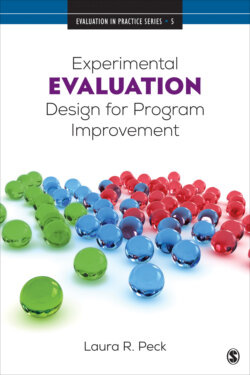Читать книгу Experimental Evaluation Design for Program Improvement - Laura R. Peck - Страница 14
На сайте Литреса книга снята с продажи.
Nudge or Opportunistic Experiments
ОглавлениеIn recent years, an insurgence of “opportunistic” or “nudge” experiments has arisen. An “opportunistic” experiment is one that takes advantage of a given opportunity. When a program has plans to change—for funding or administrative reasons—the evaluation can take advantage of that and configure a way to learn about the effects of that planned change. A “nudge” experiment tends to focus on behavioral insights or administrative systems changes that can be randomized in order to improve program efficiency. Both opportunistic and nudge experiments tend to involve relatively small changes—such as to communications or program enrollment or compliance processes—but they may apply to large populations such that even a small change can result in meaningful savings or benefits. For example, in the Fall of 2015, the Obama administration established the White House Social and Behavioral Sciences Team (SBST) to improve administrative efficiency and embed experimentation across the bureaucracy, creating a culture of learning and capitalizing on opportunities to improve government function.
The SBST 2016 Annual Report highlights 20 completed experiments that illustrate how tweaking programs’ eligibility and processes can expand access, enrollment, and related favorable outcomes. For instance, a test of automatic enrollment into retirement savings among military service members boosted enrollment by 8.3 percentage points from a low of 44% to over 52%, a start at bringing the savings rate closer to the 87% among civilian federal employees. Similarly, waiving the application for some children into the National School Breakfast and Lunch program increased enrollment, thereby enhancing access to food among vulnerable children. Both of these efforts were tested via an experimental evaluation design, which randomized who had access to the new policy so that the difference between the new regime’s outcomes and the outcomes of the status quo could be interpreted as the causal result of the new policy. In both cases, these were relatively small administrative changes that took little effort to implement; they could be implemented across a large system, implying the potential for meaningful benefits in the aggregate.
